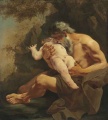Temples
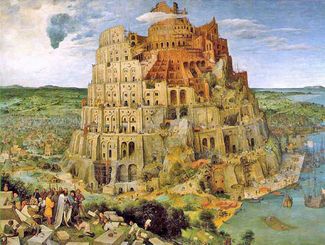
Temples of the mind
Can the Church be a temple or a temple a Church?
Were temples government buildings?
Are you a temple?
Or do you depend upon the temples made by hands?
The English word "temple" derives from Latin templum, which was originally not the building itself, but a sacred space surveyed and plotted ritually. Today we associate a temple with the buildings that have survived through history.
What was their real purpose? Are other buildings like these temples serving government purposes or religious purposes?
Or are they one in the same?
What is the difference between public and private welfare?
What were they doing in what we call pagan temples?
And who is doing the same thing now?
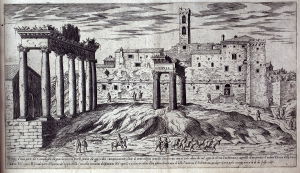
Temple of Saturn
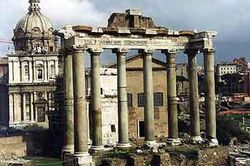
- "This unique Temple of Saturn constitutes one of the oldest cult places of Rome. Before its foundation there had been a very ancient altar and temple itself was said to have been founded in around 497 BC." [1]
The Temple of Saturn contained the treasury or "aerarium". This is where the Roman Republic vaulted its reserves of gold and silver. It also contained the state archives until they were transferred to the nearby Tabularium. Other official scale and instruments for the weighing precious metals and items like official insignia were stored there by the government for safe keeping. A flamen was a priest assigned to the oversight of these important governmental services. The temple's podium included a covered area for posting government bills and announcements.
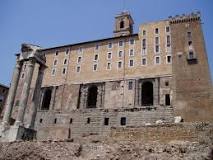
The first building for maintaining public records in Rome, including the law, was erected under the protection of the temple of Saturn, as early as 509 B.C. but was possibly burned by the Gauls in 309 B.C. Other buildings were used until 78 B.C. when they built the great Tabularium, on Capitoline Hill, below the Temple of Jupiter.
Temple of Saturn - Bureau of Vital Statistics. Parents were required to get newborns registered (birth certificate) within 30 days with the government. It was at the Temple of Saturn this government certification was kept. The reason was simple. It was so that everyone would know when the children reached the age to receive benefits of the Patronus of Rome.
- The "Aerarium Stabulum" or treasure-house was the public treasury in Rome. It was used to store monies and record accounts of the state finances, copies of public laws engraved on brass plates, a record of the decrees of the Senate and other public registries, letters of credence from foreign diplomats and even the standards of the legions. These public treasures, records and accounts were all deposited on the eastern slope of the Capitoline hill within the temple of Saturn at the Forum Romanum containing several important ancient government buildings at the center of the city of Rome.
- The "Aerarium sanctius" was a special reserve fund, also in the Temple of Saturn. It was maintained by free contributions of Generals but eventually by a 5% tax on the value of all manumitted slaves. This source of revenue was established by a lex Manila in 357 B.C. and was the equivalent of an unemployment tax. The sanctius meant it was not to be touched except in dire circumstances.
These social service once provided through free will contributions made in the sacred temple areas over the altars constructed by priestly class who saw to their fair distributions became the centers of a socialist state as the Republic declined and imperial powers rose to prominence. The faithful and Freewill offerings of ancient society had become contractual bands that bound the members of that society under the authority of the state to the Imperial Cult of Rome.
Saturn in Many Nations
It is noteworthy that, in mythology, Saturn was known for devouring his children. Three grotesque painting can be seen below. But there are also sculptures such as this one.
- Saturn Devouring His Son
-
Peter Paul Rubens, 1636
-
Giulia Lama, 1735
-
Francisco de Goya, 1819
Saturn is the Roman (or Latin) word. But the same planet/god was portrayed in many other languages...
- Chronos or Kronos is Greek
- Moloch by the Ammonites
- Baal by the Ammorites
- Phenicians and Carthaginians made it obvious by simply combining all the names: Malik-Baal-Kronos
In modern times, we tend to think of these people as barbaric groups based on bloodlines—who they were related to. A more proper perspective may be that these classifications were based upon government systems. In the case of those who "worshipped" Saturn, Molech, or Baal, it's apparent that they began with systems built upon debt heaped on the backs of their children. In the final days of these nations, this may have turned into literal child sacrifice as a socially acceptable outlet for disposing of children which were a burden to parents who didn't need to raise their own children properly in order to be provided for in their later years but, instead, could tap into government welfare programs that were paid for by other people and their children. In Egypt, babies were cast into the Nile. In Carthage, they were rolled down the red-hot arms of the metal statue of Moloch. In Rome, they were tossed out with the garbage which was collected by barges. In modern times, the ritual translates into abortion since our society finds it more convenient to dispatch babies while they are still in the womb rather than to deal with the legal hassles after they are born.
But what is the connection to the literal planet Saturn? Why has the practice of "cursing the children" with debt and then sacrificing them for the good of society been associated with the planet Saturn by a myriad of cultures throughout ancient times?
Proponents of the Electric Universe (EU) theory have made some very interesting connections that indicate that early humans may have viewed a very different sky than we currently do and we consider their stories as mythology only because we fail to recognize that they were relaying very literal astronomical data. (More to come.)
Temple of Jupiter
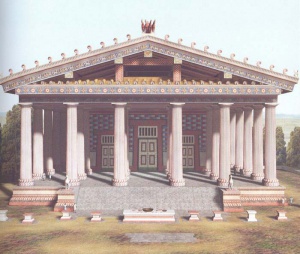
The Temple of Capitoline Jupiter which was the symbol of the sovereignty and power of Rome was dedicated to the Optimus Maximus Jupiter, together with the other two divinities that made up the Capitoline triad - Juno and Minerva. The "Tribunes" "most often conducted their legislative assemblies at the Temple of Jupiter Optimus Maximus, thereby implicitly invoking Jupiter's role as patron of the Republican political system..."[2] The building housed important records, books and ceremonial items and included a chamber below the main hall which was used to store sacrificial offerings of Qorban and other government funds including the treasury of the city. Only the priests in charge of administering these funds were allowed into these chambers and vaults.
Knowing that at the Temple of Jupiter the Tribunes not only conducted their legislative assemblies but it housed important records, books and the social welfare funds including the treasury of the city within the chambers and vaults of that temple could enhance our understanding of the Christian conflict.
Archaic Triad of Rome consisted of Jupiter, Mars and Quirinus.
The Temple of Mars
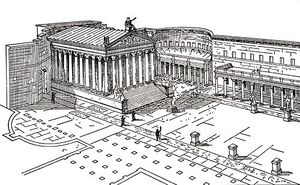
In The Temple of Mars Ultor Augustus established the "Aerarium militare" in AD 6 as well as the fiscus[3]. It was a military treasury which contained the funds for veterans' retirement benefits. Under Augustus it was largely endowed by the emperor[4] himself and supported by the proceeds of new taxes, an 5% tax on inheritances and 1% on auction-sales. It replaced the aerarium Saturni, and eventually became the municipal treasury of the city of Rome.
Temple of Quirinus
Quirinus was an epithet of Janus, Janus Quirinus, derived from the Sabine word quiris or "spear." Quirinus was the personification of all Quirites who were the brave men of the oaken spear who defended the nation as a noble people's militia. Over the century the rituals and rites, as well as the name of these deified virtues, celebrated heroes and heroines who sacrificed themselves and their wealth for the good of the people. They were often commemorated with festivals and feasts of sharing for even ancient peoples knew that only in regular sacrifice of self does a society remains sustainable.
The sacrifices of society must be free if society is to remain free.
Quirinus, sacellum: an ancient shrine on the Quirinal, near the porta Quirinalis. A statue was dedicated to Augustus in the temple as the Savior and Apotheos of Rome. Quirinus, aedes, a temple on the Quirinal hill, one of the Seven Hills of Rome. The temple was one of the oldest in Rome.
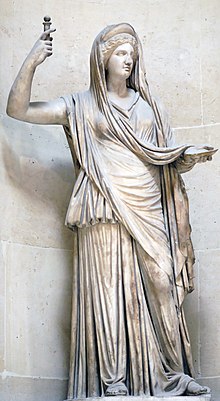
Temple of Venus and Roma
The Temple of Venus and Roma — in Latin, Templum Veneris et Romae — is thought to have been the largest temple in Ancient Rome. But also Herod the Great erected a temple of Roma in the region of Caesarea Philippi to the emperor Augustus and had already built temples to the Emperor at Caesarea Maritima and at Sebaste.
- “Herod’s strategy in erecting this temple extended far beyond the symbolism represented by the structure itself. He was among the first of all provincial rulers in the empire to commit to the cult of Augustus. His Augustan temples, and the elaborate priesthood they required, may even have been influential in setting the course of imperial worship throughout the Eastern empire. While ostensibly the act of erecting these temples represented loyalty and commitment to Rome, it also furnished a basis for the social and political organization of diverse populations such as those in Herod’s kingdom. At the same time, because the new cult left the traditional local cults intact, it represented no threat to them. In fact, it symbolized an interest in protecting the local culture.” [5]
What was the "cult of Augustus"?
It was the Imperial Cult of Rome which as a "social and political organization" included a membership through a social welfare scheme of Corban like that used by Herod and the Pharisees.
Roma in Rome
The Temple of Venus and Roma had two adjoining chambers or cellae, which contained a statue. statue.
Venus Felix was the ancient representation of the Roman people, while Roma Aeterna represented the genius of the city. Together they represented a supposedly symmetrical arrangement of the civil government and the people. The two deities evoked, Roma and Amor.
In Rome they were situated on the slope of the Velia Hill, with the Arch of Titus at one corner and the Via Sacra passing down its side with Hadrian's temple also apart of the Forum of temples and the Colosseum was faced by Venus.
After Constantine established his church the temple was stripped in AD 382 by Gratian and by AD 391 Theodosius made a series of decrees prohibiting pagan worship. Eventually a Church of Santa Francesca Romana was erected there.
Roma in Judea
Herod the Great built many buildings which provided services to people as well as being a memorial to his success as a ruler of the people. Augustus continued the civil philanthropy of Julius Caesar had begun funding through his war on the Gauls. Julius as commander in chief of his army had stripped of the wealth of the Gauls and sold hundreds of thousands of people into slavery. Instead of being tried for war crimes he appeased the people by showering them with "gifts, gratuities, and benefits".[6]
part of a plan to show his indebtedness to his benefactor Herod the Great (37–4 B.C.) built a very large temple in Caesarea Maritima dedicate to the "goddess Roma, the embodiment of imperial Rome, and to the god–king Augustus" (Holum: 45).
Although the temple does not survive, it is known from the descriptions of the Jewish historian Josephus and the excavations carried on at the site (see reference below).
From the outset, it should be remembered that Caesarea Maritima was predominantly a Gentile city—thus the "pagan" temple, but Herod also rebuilt the Temple to the God of Israel, and expanded its platform. These two building projects of Herod do indeed say something about his character and outlook on life!
Some of the above, and following, information was gleaned from Holum, Kenneth G. "Building Power — The Politics of Architecture." Biblical Archaeology Review, vol. 30, no. 5 (September/October, 2004):36–45, 57.
King Herod's Temple of Roma and Augustus at Caesarea Maritima was a similar structure but understanding the purpose of these buildings which represented a combination of civil authority and the sacrifices of the people to establish a system of Legal charity is critical to understanding their function and how they opposed the teachings of Christ.
Augustus would bestow gifts on the Greek people and build a Temple of Roma on the Acropolis aligned with the Parthenon of Athens in 19 AD. This granting of gifts, gratuities and benefits was not just to convince the people of his unbiased benefaction but create a dependence and loyalty among the masses. Herod did the same in Judea. [7]
The temple was a symbol of a divine office of Rome and Caesar as the head of the Imperial Cult of Rome which was the center of the Public religion of the Empire and its social welfare State.
These buildings were monuments to their propaganda which caused the people to hail the once humble Octavius as the now divine "Augusts Soter"[8] meaning “savior of the world”.
And of course since both the Caesars and Jesus the Christ would be called the Son of God these titles would contribute to the Christian conflict. This is why the two of them were often seen as or referred to by some as the Eagle and Dove because of the manner and methods used by them and their followers to provide for the social welfare of the people. The former like Herod and the Pharisees depended upon public Religion while the latter and His Church depended upon Pure Religion.
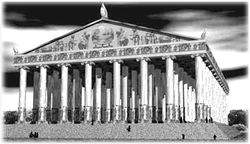
The tutelary power in these temples offered their benefits and dainties through exercising authority which by the nature of their covetous practices degenerated they very soul of the masses.
These were the "Fathers of the earth" Jesus spoke of who were using that world bank at Ephesus.
Yes, it was literally the world bank of that time.
Why were Christians accused of Robbing it?
Christians had a solution in The Way of Christ. Unfortunately the Modern Church either does not know what they were doing, why their was a Christian conflict or that the "masses" have been going away from the kingdom of God even before the New Deal of the New Babylon the great and its reset. If they did they could repent and start seeking the ways of righteousness.
The Temple at Ephesus
Temple of Diana in Ephesus Also known as the Temple of Artemis was a central bank for at least the 127 countries which built the present temple at the time of Christ and the early Church.
Because of its extensive investments and secure vault, it served as an underwriter for social welfare insurance through government investments. It was a major depository of the Corban of the Imperial Cult of Rome.
What is the meaning and significance of the Christian Apostles being accused of robbing the Temple of Ephesus.
Were Christians actually bank robbers?
Or has something been lost in translation?
- "The temple of Artemis seems not only to have been used as a religious site, but also as an institution similar to a bank. Dio Chrysostum describes how the money of private citizens was deposited in the building, and even foreigners and "commonwealths and kings", which was apparently due to the "safety" of the sanctuary.[9]
- One of the great historian of the period, Aelius Aristides described Ephesus as "Asia's greatest center of trade and banking" [10] and the temple as “the general bank of Asia" [11] The temple of Artemis “...the largest and most important bank on the west coast of Asia Minor, was inseparable to the economic structure of the city and indeed the entire province.” [12]
- "In time the temple possessed valuable lands; it controlled the fisheries; its priests were the bankers of its enormous revenues. Because of its strength the people stored there their money for safe-keeping; and it became to the ancient world practically all that the Bank of England is to the modern world."[13]
- “The temple was so rich and prosperous that it became, with the temple in Jerusalem, one of the world’s first banks.”[14] Read Investing in Diana.
In Ephesus, there was an uproar about the apostles with a reference to robbing the temple. What was actually going on in these temples?
We have seen that the temple built by Herod collected vast sums of money and contained a great treasury. Through its daily administration, it oversaw a welfare program for the needy, built aqueducts, and provided common government services.
It contained a great vault, which was considered one of the safest depositories in Asia Minor. This temple actually functioned as a world bank. What we might call the “high priest” was also a credit officer making loans and collecting interest, managing valuable property, and in charge of security for those who deposited valuables in the temple in the course of commerce and trade.
It was literally an underwriter of national social insurance systems including the coinage of money and the issuing of scrip. Ephesus was a World Bank of the world order of Rome.
Some temples acted as investment houses for mining, trade, and even military ventures. Great returns could be had with such investments in temples like Janus and Diana. The members were investors and the Temple of Diana could seat over 24,000 people. They all had reserve funds that were often controlled by men who sought power. They were all subject to corruption and abuse.
The honesty and integrity of those in charge of these great stored wealth had already come into question when Lysimachus, the successor of Alexander the Great, transferred overseeing of the operations of the funds of the temple from the priests to the more trustworthy gerousia[15], an appointed council of elders.[16]
- The "officer, although he may have been also the priest of the eponymous hero of the tribe, was essentially a patron or benefactor who gave financial aid to the prytanes in the performance of their duties." [17]
- The Gerusia administered, "the great sanctuary, far the most important thing at Ephesus, the sacred 'bank' on which the financial welfare of the city depended." [17]
- The eponymous archon, the chief magistrate, was honored as "a benefactor to the individual citizens privately and to the city publicly, and as having saved the city in a great famine by means of the grain money".[17]
But there was a way to cleansing them by making all things anew.
Fixing Banking
In the book "Temple Cleansing and Temple Bank" by Neill Q. Hamilton, explains the "function of the Jerusalem temple as a bank.[18] A brief history of banking in temples in the ancient world will prepare us for an understanding of the Jerusalem temple bank." The word Corban, meaning sacrifice, is also translated treasury which suggests the sacrifices of the people were kept in a vault like the function of the Golden calf which was a common form of protecting the Reserve funds required in many banking and welfare systems and seen in so many of the Temples throughout history like those at Ephesus and Rome.
The network of Tens that was commanded by Christ and the seven men chosen in Acts 6 formed a sort of bank to handle movement of funds. The treasury was not in a vault but the pockets and purses of the people. What was needed for the daily ministration was provided through freewill offerings or what the New Testament calls charity.
Everything about the Kingdom of God is decentralized because it is delivering a power of choice or liberty to individuals rather than to a central power.[19]
The Daily bread which was rightly "divided from house to house" was provide in the early Christian community by a Corbanus of fervent Charity. This practice of "Pure Religion" by the early Church was a part of the "daily ministration" we see in Acts 6 and could include "food, clothing, and support" translated "meat" in Acts 2:46[20]
These Seven men were to serve tables but that did not mean to run a food kitchen. What it had to do with managing funds that might be needed to provide aid in distant lands especially during the dearths that were coming.
Christians were investing in the Kingdom of God but Jesus had opposed the idea of central banks where thieves and robbers could break in and steal your money or "moths" could eat it up.[21] He and John the Baptist had preached another way of providing social security through charitable practices charity and voluntarism.
Many who had once invested in the Ephesus were now investing in the system of daily ministration set up and appointed by Jesus through the early Church. The Christians did not have a need for a central bank nor a ruling class for they were organized in a network of Tens as Christ commanded. Their public ministers were titular "bondservants" who did not exercise authority one over the other like the Fathers of the earth and those men who called themselves benefactors.
Peter and the Apostles would appoint Seven men who by mutual election would attend to the business of the Church which was being neglected.[22]
Temple of Neptune
Temple of Neptune (Hera)at Paestum
Minerva is one of three virgin goddesses along with Artemis and Hestia, known by the Romans as Diana and Vesta.
Minerva, the Roman goddess of wisdom peace and the arts which is why Guilds of Smith donated to the construction of her buildings.
Parthenon's double function as a religious temple and a treasury but "religion" was what you did to care for the needy of society.
A back room in temples was called the opisthodomos. It usually served as a storage space for cult equipment which included means to weigh and measure offerings and stamp coins or even change the content of coins. These rooms also included vaults to hold the temple treasury.
The opisthodomus of the Athenian Parthenon housed the treasury of the Delian League. Pronaos, anticum or prodomus which were often open areas and opisthodomos were often closed off from the peristasis (four-sided porch or hall of columns) by wooden barriers or fences.
Pericles during the Peloponnesian wars counted on his "reserve fund" which included the "40 talents worth of gold plates on the statue of Athena on the Acropolis that they could remove and melt down in an emergency".[23]
These golden statues, like the golden calf, were always considered to be a way of depositing funds in a central bank to protect societiety from poverty and calamity.
Temple of Artemis
Pliny describes the temple as 377 feet (115 meters) long and 180 feet (55 meters) wide, made almost entirely of marble, making its area about three times as large as the Parthenon.
Prytanea or Vestal Temples
Prytaneum was a Court where the Senates or Council of a city met. as did the Sanedrim in the Temple of the Jews.
It was used in the performance of the obligations that belonged to the chief Magistrates of the City or State government.
These rulers often took on the responsibility of the Pontifex Maximus to insure the honesty of those who performed the charitable care of society in areas of health, education and welfare. They were overseers of the public trust like we see in the instances of Melchizedeck, Abraham or David as the overseer of the Porters of the temple and of course Jesus and the money changers.
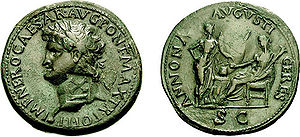
The Parthenon was originally built as a temple to the Greek Goddess Athena. In Rome there was the Pantheon.
The alimenta (to feed) was a Roman welfare program initiated by emperor Nerva and expanded by Trajan. It used public funds rather than just private donations to feed poor children. It was to help the orphans and poor children throughout Italy.
Similar program were instituted through temples since before Polybius. Plutarch as well as Polybius warned that government finance of these programs would degenerate and destroy the masses.
Cura Annonae ("care of Annona") was done in honour of their goddess Annona, to describe the import and distribution of grain to the residents of the cities of Rome. The grain dole or corn dole in cities like Rome was a government program which gave out free or subsidized grain, and later bread, to about 200,000 of Rome's adult male citizens. While this was originally an emergency measure to help feed people during a major dearth it became an addiction for the masses and a tool for tyrants.
the "ALIMENTA" like the Corban of the Pharisees or the [[free bread or Bread and circuses was designed to feed the poor on a regular basis with bread, meats and fruit and win the popular support of the masses with benefits through the public supported temples.
FDR and LBJ instituted similar programs of legal charity like the New Deal to provide a social safety that was a snare.
Temple of Juno Moneta

According to Livy, during the Republic, the mint was on the Capitoline Hill, either in, or very near, the temple of Juno Moneta.[24] Minting coins was under the dominion of the Senate but the one who was in charge was called the "Moneyers" who produced coins with generic images commemorating Roman achievements. Under the Empire, the emperors had direct control of coinage.
Trajan (r. 98–117) seemed to have an additional mint based on some dedicatory inscriptions indicates there may have been the office of "Moneta Caesaris" on the Caelian Hill which survived into the third century[25] and the remaining mint was closed by 476 AD.
The "Rationibus" held an Imperial office to determine the total output of coins. Under him was the "Procurator Monetae".[26] The "Optio et Exactor auri argenti et aeris"[27] was actually in charge of the operation of minting and overseeing quality control.
The Temple of Juno Moneta (Latin: Templum Iunonis Monetæ) was an ancient Roman temple that stood on the Arx or the citadel on the Capitoline Hill overlooking the Roman government Forum. The word Money is from a Middle English word from Old French moneie, from Latin moneta ‘mint, money’. It was an original title of the goddess Juno, in whose temple the money of Rome was minted. In addition, it was the place where the books recording the legal opinions of the magistrates and judges, who were the gods of Roman Courts were deposited. These gods decided what was good and what was evil and the other Weightier matters of society.
Temple of Ceres
In ancient Roman religion, Ceres was by myth the personification of a goddess of agriculture, grain crops, fertility and motherly relationships. The free bread or grain dole was distributed from her Temple of Ceres which was a part of the Public religion of Rome Christians came into conflict with at the time of Saturninus whose political platform lowered the price of grain. Julius Caesar reformed the dole and Augustus lowered the number of recipients to 200,000 but this Covetous Practices was already taking its toll upon the moral integrity and financial stability of society.
Temple of Concord and Castor
In the Temple of Concord and Castor there were rooms cut in solid rock used as a repository of the treasury where it is said "that private citizens also deposited their money in the temple for safekeeping".[28] There was a statue to Salus in the temple of Concordia. Salus, (Latin: salus, "safety", "salvation", "welfare"[29])was the goddess of safety and well-being. including welfare, health and prosperity, of both the individual and the state.
Temples of Religion
Temples were places where public religion and worship occurred but to understand what that means you must understand what Religion was supposed to be.
Public religious ceremonies took place outdoors, and not within the temple building. Some ceremonies ended with a temple or shrine, where a ritual object might be stored and brought out for use, or where an offering would be deposited. Sacrifices, like animals, would take place at an open-air altar within the templum and were eaten at festivals or distributed to the poor as a part of the public social welfare in the case of public religion.
The real Church established by Christ must be the temple of Pure Religion. The temple of God is made of living stones who care about one another in the love of Christ. They function through charity while the Temples of the world force the contributions of the people under the authority of men like Cain and Nimrod.
The Christian conflict with the people who persecuted them in the early days of the Church was mostly over their system of social welfare which was managed through their temples like Ephesus, Temple of Saturn and the Parthenon.
Romans had superstitions but they were practical people. They did not build without a purpose an a plan. Saturn was the god of agriculture. Agriculture needs calendars and records.
Temple of Nebo
Parents sent their children to the Temple of Nebo to receive their public education. Nebo was the Mesopotamian god of education, wisdom and oracles. Supporting the temple was supporting the education of the people and almost always included the largest and most elaborate libraries.
As Romans began to dominate a large part of the Greek world, Rome's Conscripted fathers there were given the same divine honours as were Hellenistic rulers. The people believed there was a spiritual connection to a god that attributed success to their heroes and saviors.
This hero worship may seem innocent like the adoration given to celebrities today. They did some time save society as in the case of Scipio Africanus, victor over Hannibal, whose death mask was stored in the temple of Jupiter; an by Ennius epitaph said that he had ascended to Heaven. It was believed by many that he had been inspired by prophetic dreams, and was himself the "son of Jupiter". This did not suggest just that he was begotten as much as adopted or was spiritually connected or guided by that god's character.
The temples besides providing functions of social welfare were also museums and place to commemorate the past. Several men were viewed as military or political saviors. In the 70s BC, Roman loyalist greeted the proconsul Metellus Pius as a savior, burning incense "as if to a god" for putting down the Lusitanian rebellion in Spain. Octavius was hailed as savior and given the title of Augustus as he marched into Rome after the civil war that made him Emperator, commander in chief of the army and navy.
Gaius Octavius had restored the pax deorum (divinely ordained peace) and was accepted as the Augustus, meaning "majestic," "the increaser," or "venerable". This position of adoration and respect evolved within the Senate. He was the princeps or primus inter pares (first among equals). He was to curb to the corruption of the ambitious and regulate rivalries that had led to the civil wars. Augustus' principate was made him censor and pontifex maximus. His expanded wealth due to the spoils of war allowed him to support the charitable welfare through the temples which increased his popularity.
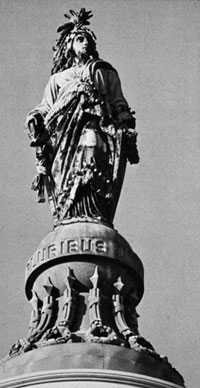
The mos maiorum [30] It is the core concept of Roman traditionalism which had rose to greatness through the network of hearths who voluntarily came together to support the Republic.
The importance of the Roman Familia was symbolized by Vesta the virgin goddess of the hearth, home, and family in Roman religion. But that religion was the traditional custom of families helping and caring for families. Volunteerism in the practice of the Social Virtues was the core to the success of the Roman society.
As individual responsibility waned during the rise of a more socialist state and mutual love of neighbor declined during the rise of power and centralization of government authority the noble hearts of society were replaced by more selfish and self-serving spirit. History repeats itself.
More than two thousand years ago among the ancient Romans the people honored the Goddess of Freedom. She was called Libertas, the Latin word for Freedom. Libertas signified both personal and social liberty, freedom of action, independence, rights, and freedom from restraint.personal and social liberty. This Goddess of Freedom merged with the chief Roman God Jupiter, in the form of Jupiter Libertas, whose feast was celebrated on April 13.
Bread and Circuses
Eventually when the Roman State became the Benefactors of the people through its systems of welfare parents where required to register newborns (birth certificate) within 30 days at the Temple of Saturn so that everyone would know when the children reached the age to receive benefits.
We see the temples were not only store houses of birth and family records but also funds that financed public works from construction to soldiers of war and their pensions.
The gifts given by Augustus was unprecedented in Roman history but so was his wealth after defeating and confiscating so much property of his opponents during the civil war.
A congarium or congiary was a vessel that was used to hold a measure of wine or oil. A congius was equal to six sextarii.
Tiberius gave a congiarium of 72½ denarii (300 sesterces) to each citizen. Caligula gave the same amount of three hundred sesterces on two occasions. Nero, whose congiaria were the earliest known examples represented on medals, gave four hundred.
It became a term for liberal donations to the people and to the soldiers including oil, wine, grain, or money, or other things.
Trajan had a practice of giving extravagant congiaria to the people of Rome. His first congiarium, in 99, was probably no larger than that of Nerva (75 denarii per person), but after each Dacian War distributions of money amounted to 650 denarii per person.
Hadrian treated the Roman people in the same way.
From the Nerva ailmenta Trajan ordered distributions to orphans and needy every month by the “praefecti alimentorium”.
Under Pliny the younger welfare increased the number of healthy children when age limits were raised to 18 for boys and 12 for girls.
Marcus Cornelius Fronto, Roman grammarian, rhetorician and advocate and suffect consul of 142 AD said:
- I consider it good policy that the prince did not neglect the theater or the circus and arena, as he well knew that there are two things which the Roman applaud especially—the distribution of grain, and games. The neglect of the important thing (free bread) causes great harm, of the frivolous thing (circuses) greater hatred—the crowd hungering more for games than for bread, because by the gift to the people (congiarium)] only those who are authorized to receive the grain will be gratified, while by the games the whole population is pacified.[31]
This was all a part of the Roman welfare system supported by taxes and tribute.
Jewish Temples
Temple of Herod
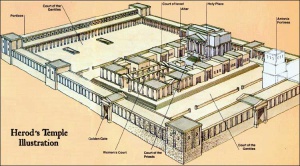
Early Israel only built a tabernacle that moved about but it was a central part of a network of Levites and altars which created social bonds of "pure religion" funded through "freewill offerings" that was to keep a "peculiar people" both strong and free.
The Levites were to help keep Israel free from returning to the bondage of Egypt by providing charitable services of the LORD. That social safety net for society was the table that would not to become a snare like the tables and dainties offered by rulers.
After the people rejected God in 1 Samuel 8 and asked for a central government under Saul things began to get worse. The power given Saul began to corrupt him and he foolishly forced a sacrifice of the people.[32]
Many nations became dependent upon central governments and stone temples and their treasuries which were filled with the forced offerings or tribute of the people. Israel had had their golden calf before the Levites were called out and became the Church in the wilderness and the David started building a stone temple but repented. Solomon who increased the yoke of the people built the first temple and later in Ezra a modest Second Temple was built.
Herod as an Herodian king started many building projects including the Temple in Jerusalem and the support buildings for the Temple Mount. He also built the temple of Roma to provide the social welfare safety net for Romans like the Corban of the Pharisees did for Jewish Judeans.
He had a grand scheme of a world wide membership in his system of social security, run through his temples. Religion was how people took care of the needy of their society.
These new temple included the custom of legal charity, and like the Corban of the Pharisees, degenerated the masses into perfect savages as warned by Polybius.
This truly was “a new form of Judaism" that Jesus would condemn because it made the word of God to none effect.
Those baptized into Herod's government welfare system went to Herod's temple to receive the benefits offered by the temple, the "meats", from his "table". This was a Social Security providing public benefits distributed through local synagogues. More on the two types of baptism.
Judea began following this Roman and ancient social model that reached back to the days of Babylon and Nimrod in earnest with Herod the Great's great society. He provided a social safety net with its own free Bread and circuses with a system dependent upon registration through the synagogues and temples of Jerusalem and Roma.
His system for the Jew would include Baptism, scribes to do the accounting and a Corban that would make the word of God to none effect. King Herod also built temple for the same function as his Temple in Jerusalem including King Herod's Temple to Roma and Augustus.
Herod the Great had a grand scheme of a vast membership in a social welfare scheme called Corban.[33] You joined with a ceremony of ritual baptism after filing an application for membership with the administering “scribe”.[34] Payment of prescribed fees was required and annual accounting of what you paid or did not pay was made available to the proper authorities.
With annual contributions collected and recorded by the scribes this system of individual sacrifice to support the needy of society became popular with many people who were jealous and envious of the rich or just covetous of their neighbor’s goods. With guaranteed entitlements and forced contributions the apathy and avarice of the people flourished.
Members were given a white stone as a form of national ID[35] and Herod was able to expand his hope of a kingdom of God on earth by this religious system of social security (Corban) which provided for a statutory enforcement and collection from membership in the form of a tax.
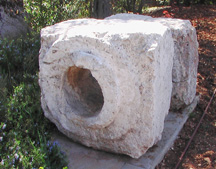
Herod and the Pharisees with the help of a corrupt Sanhedrin had set up a system of social security where citizens had to pay in as registered members. This system of Legal charity by force would "make the word of God to none effect" and the people wold become human resources for the rulers who called themselves benefactors. This system of Corban would also cause families to breakdown as the primary social unit and curse children as a surety for the debt of the New Deal. It would eventually divide society rather than bring them together, weaken the poor like the Sin of Sodom, and degenerate individuals into perfect savages.
Pilate "... used the sacred treasure of the temple, called corban (qorban), to pay for bringing water into Jerusalem by an aqueduct. A crowd came together and clamored against him..."[36] Because those funds were for their individual social welfare and the people complained.
Few understood that what should have been for their welfare had brought them into bondage though they had been warned centuries before in the sacred text.[37] Paul and others repeated that warning for the First century Church.[38] But Modern Christians are oblivious because they hire pastors who tickle their ears with Christian fables.
Building a central temple of dead stone was never a part of God's plan for men. It was Lively Stones of a Living Altar which is God's plan for mankind. Jesus Christ knew why the "ancient men" wept in Ezra 3:12 at the building of the Second Temple[39] and came to take the kingdom of God from the Pharisees and men who did not bear fruit and was building that original temple of lively stones with men of faith who let God write upon their heart and upon their minds.
LISHKAS HAGAZIS
Lishkas Hagazis was known as the Chamber of Hewn Stone It was the top of the Jewish legal system. It was their supreme court building. Here the Sanhedrin, seventy-one judges met. They dealt with the more difficult cases and was the court of final appeal in all matters of Jewish law. They also gave the final approval for a Jewish king to go to war, oversaw the function of the Temple and of course the temple was a government building.
Religious Temples
Why do I say these welfare systems of social security was religious systems?
“Pure religion and undefiled before God and the Father is this, To visit[40] the fatherless and widows in their affliction, [and] to keep himself unspotted from the world.” James 1:27
John the Baptist offered a similar plan of social welfare but without the use of force used to collect the contributions of his people which is so common in the systems of the World.[41] His plan was based on freewill offerings like ancient Israel[42] when it was still a Republic under God.[43] Christ objected to the plan offered by Herod and the Pharisees[44] not only because it made men rulers over their brothers and weakened the character of the people, and therefore society as a whole, but it also violated the precepts of God found in the Ten Commandments.
Jesus preached a system of social welfare that operated under the perfect law of liberty[45] by faith, hope and charity.[46]
Real Christians stood fast in the liberty of Christ [47] and cared for each other through their own system of social welfare managed by the Church which was a voluntary network of servant ministers. [48]
The Church in those days actually understood the Gospel of the Kingdom appointed by Christ and would never send their people to the men of government that called themselves benefactors but exercised authority one over the other in opposition to His specific instructions.[49]
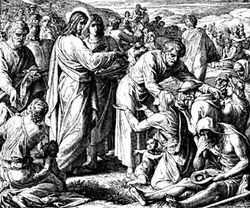
The early Church called people to repentance of that system and the new baptism of John. This was not just some meaningless ritual. They would no longer covet their neighbor’s goods through the agency of Herod’s socialist government nor Rome’s free bread and extensive welfare state offered through their government Temples. They learned to care for one another in a Network of love and service.
Today's government buildings that offer the welfare of society are fulfilling the same role as those Pagan Temples and civil Altars of Rome. The Modern Christians have abandoned The Way of Christ. They say Lord Lord in their Churches but they are not Doers of the will of their Father in heaven. The Contracts, Covenants and Constitutions that have made them subject to the unrighteous Mammon and bound them as a Surety for debt and cursed their Children and made them little more than Merchandise is not the problem but the symptom.
We must form the living Altars of Christ like the early Christians did. Before we can escape from the covenants of the world we must daily seek to wash ourselves in His blood, His sacrifice, by loving one another in real ways, laying down our life, our comfort, our judgment and unforgiveness and strive to seek His kingdom and His righteousness.
The problem is that you have forgotten what it means to love one another, care for one another, sacrifice for one another. Sacrifice draws you near to God. You must repent and return to The Way of the prophets and not forsake the assembling of you selves together in the Corban of Christ. You must assemble yourselves in order to truly attend to the Weightier matters of the law, judgment, mercy, and faith which include caring for the needs of our neighbors and the widows and orphans of our society through Pure Religion in matters of health, education, and welfare. We are NOT to provide for the needy of society through the Covetous Practices and the men who call themselves benefactors but who exercise authority one over the other like the socialists do.
The Way of Christ was like neither the way of the world of Rome nor the governments of the gentiles who depend on those fathers of the earth through force, fear and fealty who deliver the people back in bondage again like they were in Egypt. Christ's ministers and true Christians do not depend upon systems of social welfare that force the contributions of the people like the corban of the Pharisees which made the word of God to none effect. Many people have been deceived to go the way of Balaam and the Nicolaitan and out of The Way of Christ and have become workers of iniquity.
The Christian conflict with Rome in the first century Church appointed by Christ was because they would not apply to the fathers of the earth for their free bread but instead relied upon a voluntary network providing a daily ministration to the needy of society through Faith, Hope, and Charity by way of freewill offerings of the people, for the people, and by the people through the perfect law of liberty in Free Assemblies according to the ancient pattern of Tuns or Tens as He commanded.
The modern Christians are in need of repentance.
"Follow me!" —Jesus the Christ.
- One of the most important things to do is to become involved in a network of Charitable Practices. Everyone should want to join a Living Network of Love and Charity.
- If you think you have a calling to be a Minister of God or you might want to dedicate your life to Christ as an Ordained Minister of His Holy Church, contact us to start the process of discipleship and become the benefactors who exercise only love, NOT authority.[50]
Also read more on how Christians weren't registered in central government of the day.
The Christians depended on a Holy temple made of living stones which was a network of people living by the perfect law of liberty and faith, hope and charity. Those that had shared with those who had true needs.
Related Articles
- 2014-01-21 Evidence The Temple Was NOT God’s Will
Temple links
Temples |
Temple of Diana |
Temple in Jerusalem |
Temples of Herod |
Sumer | Jehovahnissi | Nasi |
Turtledove | Goddess | Ishtar |
Temples Banks and the Brokerage House |
Edward Mandell House |
Ephesus |
Temples of Herod |
Temples and Churches |
Golden calf |
The Bank of the Golden Calf |
Graven images |
Altars |
Corban |
Red Heifer |
Treasury |
Reserve fund |
Religion |
Private welfare |
Public religion |
Legal charity |
Nimrod |
City-state |
Sumer |
Gods |
Goddess |
Mystery Babylon |
Saving Babylon |
Exiting Babylon |
One purse |
Merchandise |
Benefactors |
Stones |
Corban |
Welfare types |
Religion |
Pure Religion |
Private welfare |
Fleeing Religion |
False religion |
Public religion |
Our Religion |
Christian conflict |
Corban |
Baptism |
Benefactors |
That Word |
Daily ministration |
Modern Christians |
Diocletianic Persecution |
Christians check list |
gods |
Judge not |
Judge |
Fathers |
Deist |
Damnable heresies |
Factions at the altar |
Pharisees |
Sadducees |
Zealot |
Essenes |
Levites |
Messianic Judaism |
Menahem the Essene |
Sanhedrin |
Altars |
Clay and Stone |
Red Heifer |
Golden calf |
Freewill offerings |
Religion |
Pure Religion |
Public religion |
Christian conflict |
Paganism |
Denominations |
Dispensationalism |
Benefactors |
Corban |
Daily ministration |
Calendars |
Cult |
Imperial Cult of Rome |
Guru theories| |
Covet |
Merchandise |
Mark of God |
Mark of Cain |
Mark of the Beast |
Nature of the Beast
Section 666 |
Benefactors |
Biting one another |
Cry out |
Worship |
Church |
Temples |
Religious Orders |
Priests |
Kings and priests |
Hear |
Bible Index |
Network |
Economy |
Spiritual Economics |
Capitalism |
Socialism |
Divers lusts |
Business |
Kingdom Business |
Welfare |
Surety |
Temples |
Temple of Diana |
Temple in Jerusalem |
Seven Men |
Money Audio |
Real Money |
Money can be anything |
Debt Money |
Money as debt quotes |
Bitcoin |
Cashless |
Money |
I paid in |
Commodity money |
Value |
Mammon |
Covet |
Merchandise |
One purse |
Road Map |
Golden calf |
Temples |
Treasury |
Moneychangers |
The Bank of the Golden Calf | Study audio
Seven men |
Reserve fund |
Ephesus |
Tithe |
Sabbath |
Credit unions |
Thy first love |
HHC Money vs Mammon >
>Audio |
Conversion vs Reconversion >
>Audio |
See more Forbidden Definitions
Footnotes
- ↑ Inconsistencies in Greek and Roman Religion: Transition and Reversal in Myth and Ritual. Tome II By H. S. Versnel
- ↑ Public Office in Early Rome: Ritual Procedure and Political Practice. By Roberta Stewart
- ↑ Fiscus, from which comes the English term fiscal, was the name of the personal treasury of the emperors of Rome. The word is literally translated as "basket"
- ↑ Emperator was the Latin title meaning commander in chief and originally a ten year term of office.
- ↑ Caesarea Philippi: Banias the Lost City of Pan by John Francis Wilson, p. 13.
- ↑ "That the man who first ruined the Roman people twas he who first gave them treats and gratuities" Plutarch's Life of Coriolanus (c. 100 AD.)
- “The real destroyers of the liberties of the people is he who spreads among them bounties, donations, and benefits.” Plutarch
- ↑ "The annual Temple-tribute was allowed to be transported to Jerusalem, and the alienation of these funds by the civil magistrates treated as sacrilege. As the Jews objected to bear arms, or march, on the Sabbath, they were freed from military service. On similar grounds, they were not obliged to appear in courts of law on their holy days. Augustus even ordered that, when the public distribution of corn or of money among the citizens fell on a Sabbath, the Jews were to receive their share on the following day. In a similar spirit the Roman authorities confirmed a decree by which the founder of Antioch, Seleucus I. (Nicator),[d Ob.280 B.C.] had granted the Jews the right of citizenship in all the cities of Asia Minor and Syria which he had built, and the privilege of receiving, instead of the oil that was distributed, which their religion forbade them to use, [e Ab. Sar ii. 6] an equivalent in money. [Jos.Ant. xii. 3. 1] These rights were maintained by Vespasian and Titus even after the last Jewish war, notwithstanding the earnest remonstrances of these cities. No wonder, that at the death of Caesar [g 44 B.C.] the Jews of Rome gathered for many nights, waking strange feelings of awe in the city, as they chanted in mournful melodies their Psalms around the pyre on which the body of their benefactor had been burnt, and raised their pathetic dirges." Life and Times of Jesus the Messiah by Alfred Edersheim, Chapt. V
- ↑ original inscription: "The People (dedicate) to the Goddess Roma and Augusts Soter, when the hoplite general was Pammenes, son of Zenon, of Marathon, priest of the Goddess Roma and Augustus Soter on the Acropolis, when the priestess of Athena Polias was Megiste, daughter of Asklepiades of Halai, in the archonship of Areios, son of Dorion, of Paiania." IG II3 4, 10 Dedicatory inscription on the temple of Roma
- ↑ Dio Chrysostum, Greek orator, writer, philosopher and historian of the Roman Empire in the 1st century, Or.31.54. Temple of Artemis at Ephesus, The University of Warwick
- ↑ History of Ephesus
- ↑ Aelius Aristides (Orations 23.24) Cf Murphy-O'Connor 2008:23, 65.
- ↑ Ephesians and Artemis: The Cult of the Great Goddess of Ephesus as the Epistle's Context By Michael Immendörfer. see chapter 4.1.3.2. Bank.
- ↑ from International Standard Bible Encyclopedia, Electronic Database Copyright (c)1996 by Biblesoft
- ↑ Trinity College of Biblical Studies
- ↑ In Sparta the Gerousia was composed of men over the age of sixty, an office created by Lycurgus in the seventh century BC, in his Great Rhetra.
- ↑ Strabo 14.1.21.
- ↑ 17.0 17.1 17.2 THE AMERICAN EXCAVATIONS IN THE ATHENIAN AGORA HESPERIA: [SUPPLEMENT VI, THE SACRED GERUSIA], BY JAMES H. OLIVER
- ↑ Mark 11:15-19, Luke 19:48-49, Matthew 21:12,13
- ↑ Matthew 6:19 Lay not up for yourselves treasures upon earth, where moth and rust doth corrupt, and where thieves break through and steal: 20 But lay up for yourselves treasures in heaven, where neither moth nor rust doth corrupt, and where thieves do not break through nor steal::21 For where your treasure is, there will your heart be also.
- ↑ "And they, continuing daily with one accord in the temple, and breaking bread from house to house, did eat their meat with gladness and singleness of heart," Acts 2:46 The word in the text translated "meat" is the Greek word "trophé " 5160 Commonly translated food, nourishment, and support. And accepted literally and figuratively by implication, rations (wages), food, meals, and meat.
- ↑ Matthew 6:20 But lay up for yourselves treasures in heaven, where neither moth nor rust doth corrupt, and where thieves do not break through nor steal:
- ↑ Acts 6:2 Then the twelve called the multitude of the disciples [unto them], and said, It is not reason that we should leave the word of God, and serve tables.
- ↑ The Making of Strategy: Rulers, States, and War By Williamson Murray
- ↑ Livy 6.20.13.
- ↑ Noreña 2011, 191
- ↑ 5 Be Woytek 2012, 101. Cf. Stat. Silv. 3.3.104–105.
- ↑ Reviewer and Supervisor of the gold, silver and bronze
- ↑ Ancient History pamphlets, Volume 3
- ↑ M. De Vaan Etymological Dictionary of Latin Leyden 2010 s.v.; The Oxford Classical Dictionary 4th ed. London & New York 2012 s.v.
- ↑ "ancestral custom" or "way of the elders," is the unwritten code of Romans derived from respected noble families who established social norms.
- ↑ Fronto, Prim. Hist., p. 249, ed., Barthold Georg Niebuhr.
- ↑ 1 Samuel 13:12 Therefore said I, The Philistines will come down now upon me to Gilgal, and I have not made supplication unto the LORD: I forced myself therefore, and offered a burnt offering. 13 And Samuel said to Saul, Thou hast done foolishly: thou hast not kept the commandment of the LORD thy God, which he commanded thee: for now would the LORD have established thy kingdom upon Israel for ever. 14 But now thy kingdom shall not continue: the LORD hath sought him a man after his own heart, and the LORD hath commanded him [to be] captain over his people, because thou hast not kept [that] which the LORD commanded thee.
- ↑ Mark 7:13 “Making the word of God of none effect through your tradition, which ye have delivered: and many such like things do ye.”
- ↑ Scribe is from the Greek grammateus meaning “a clerk, scribe, esp.a public servant, secretary, recorder, whose office and influence differed in different states”
- ↑ “The missionaries… with their... white stones, would come back with the same wallets full of money, in foreign currency. Once put into Jewish currency by the money-changers [porters of the temple], it would be stored in vaults ...Herod’s scheme of initiation into a new form of Judaism was immensely successful....” Jesus and the Riddle of the Dead Sea Scrolls by Barbara Thiering, Harper Collins: 1992
- ↑ 20The Aqueduct- Josephus, War 2.175-177, Antiq 18.60-62.
- ↑ 22“And David saith, Let their table be made a snare, and a trap, and a stumblingblock, and a recompence unto them:” Romans 11:9. Exodus 20:17, Exodus 23:32, Exodus 34:12...; Proverbs 1:10, Proverbs 23:1...; Romans 13:9, Mark 7:22, Matthew 5:34, James 5:12, 2 Peter 2:3
- ↑ Episkeptomai “ to look upon or after ... have care for, provide for:”
- ↑ Ezra 3:12 But many of the priests and Levites and chief of the fathers, [who were] ancient men, that had seen the first house, when the foundation of this house was laid before their eyes, wept with a loud voice; and many shouted aloud for joy: 13 So that the people could not discern the noise of the shout of joy from the noise of the weeping of the people: for the people shouted with a loud shout, and the noise was heard afar off.
- ↑ Matthew 11:12 “And from the days of John the Baptist until now the kingdom of heaven suffereth violence [biazo=to use force, to apply force, violence], and the violent [biastes] take it by force [harpazo = to seize, carry off by force].” Luke 16:16 “ The law and the prophets [were] until John: since that time the kingdom of God is preached, and every man [all] presseth [biazo] into it.”
- ↑ Matthew 11:12 “And from the days of John the Baptist until now the kingdom of heaven suffereth violence [biazo=to use force, to apply force, violence], and the violent [biastes] take it by force [harpazo = to seize, carry off by force].” Luke 16:16 “ The law and the prophets [were] until John: since that time the kingdom of God is preached, and every man [all] presseth [biazo] into it.”
- ↑ Exodus 35:29, 36:3, Leviticus 7:16, Leviticus 22:18-23, Leviticus 23:38, Numbers 15:3, Numbers 29:39, Deuteronomy 12:6, Deuteronomy 12:17, Deuteronomy 16:10, Deuteronomy 23:23, 2 Chronicles 31:14, 2 Chronicles 35:8, Ezra 1:4, Ezra 3:5, Ezra 7:13-16, Ezra 8:28, Psalms 54:6, Psalms 68:9, Psalms 110:3, Psalms 119:108, Ezekiel 46:12, Hosea 14:4, Amos 4:5.
- ↑ Luke 3:11 “He answereth and saith unto them, He that hath two coats, let him impart to him that hath none; and he that hath meat, let him do likewise.”
- ↑ The Corban of the Pharisees, http://www.hisholychurch.org/sermon/corban.php
- ↑ James 1:25 “But whoso looketh into the perfect law of liberty, and continueth [therein], he being not a forgetful hearer, but a doer of the work, this man shall be blessed in his deed.”
- ↑ 1 Corinthians 13:13 “And now abideth faith, hope, charity, these three; but the greatest of these [is] charity.”
- ↑ Galatians 5:1 “Stand fast therefore in the liberty wherewith Christ hath made us free, and be not entangled again with the yoke of bondage.”
- ↑ “And they who are well to do, and willing, give what each thinks fit; and what is collected is deposited with the president, who succours the orphans and widows and those who, through sickness or any other cause, are in want, and those who are in bonds and the strangers sojourning among us, and in a word takes care of all who are in need.” The Church government in 150 AD are described in Justin’s First Apology which was explaining how the church worked to the Emperor:
- ↑ Luke 22:25 “And he said unto them, The kings of the Gentiles exercise lordship over them; and they that exercise authority upon them are called benefactors. But it shall not be so among you:” Matthew 20:25, Mark 10:42.
- ↑ Matthew 20:25-26 But Jesus called them unto him, and said, Ye know that the princes of the Gentiles exercise dominion over them, and they that are great exercise authority upon them. But it shall not be so among you: but whosoever will be great among you, let him be your minister;
Mark 10:42-43 But Jesus called them to him, and saith unto them, Ye know that they which are accounted to rule over the Gentiles exercise lordship over them; and their great ones exercise authority upon them. But so shall it not be among you: but whosoever will be great among you, shall be your minister:
Luke 22:25-26 And he said unto them, The kings of the Gentiles exercise lordship over them; and they that exercise authority upon them are called benefactors. But ye shall not be so: but he that is greatest among you, let him be as the younger; and he that is chief, as he that doth serve.
About the author
Subscribe
HELP US at His Holy Church spread the word by SUBSCRIBING to many of our CHANNELS and the Network.
The more subscribers will give us more opportunity to reach out to others and build the network as Christ commanded.
Join the network.
Most important is to become a part of the Living Network which is not dependent upon the internet but seeks to form The bands of a free society.
You can do this by joining the local email group on the network and helping one another in a network of Tens.
His Holy Church - YouTube
https://www.youtube.com/user/hisholychurch
Bitchute channel will often include material that would be censored.
https://www.bitchute.com/channel/o6xa17ZTh2KG/
Rumble Channel gregory144
https://rumble.com/user/gregory144
To read more go to "His Holy Church" (HHC) https://www.hisholychurch.org/
Brother Gregory in the wilderness.
https://www.youtube.com/channel/UCJSw6O7_-vA4dweVpMPEXRA
About the author, Brother Gregory
http://hisholychurch.org/author.php
PreparingU - YouTube
https://www.youtube.com/channel/UC9hTUK8R89ElcXVgUjWoOXQ
Facebook
https://www.facebook.com/HisHolyChurch

